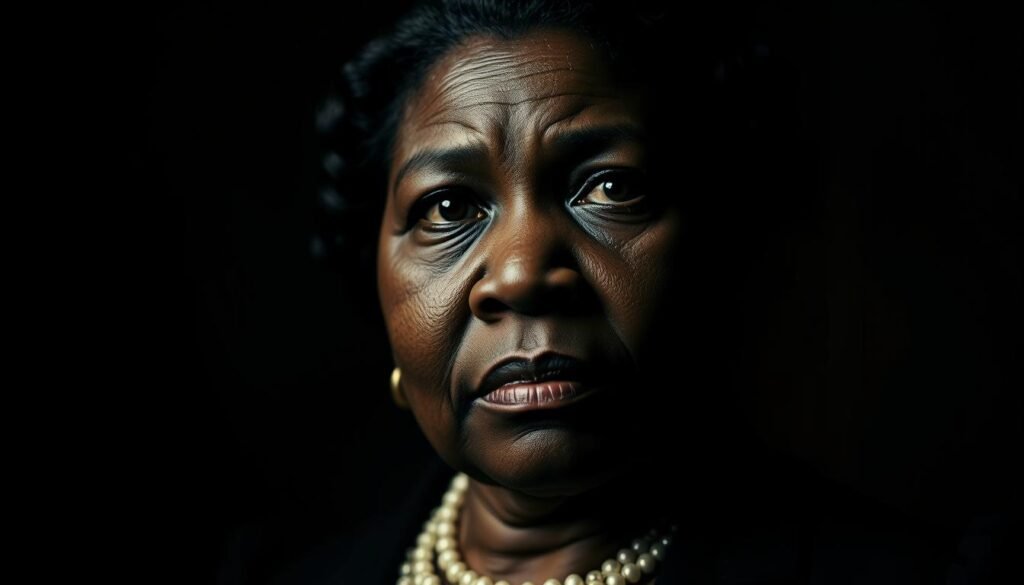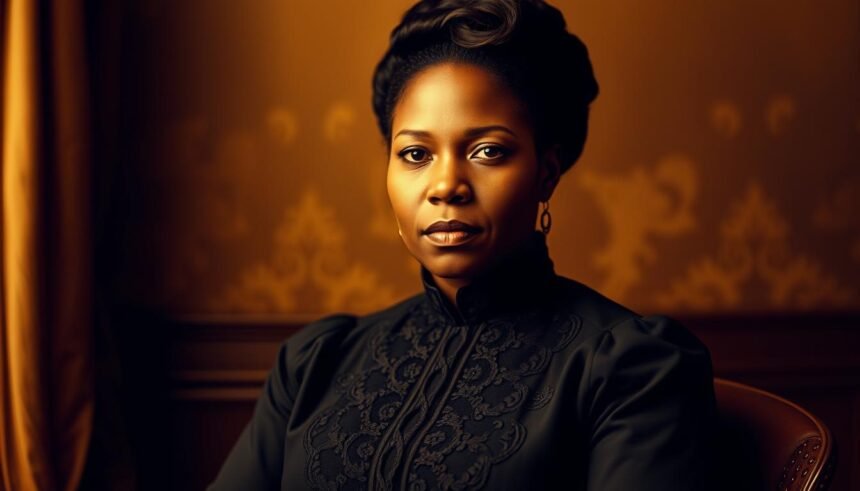Madam C.J. Walker, born Sarah Breedlove in 1867, was a trailblazing entrepreneur who revolutionized hair care for Black women in the early 20th century.
She transformed from a laundress to a business icon, overcoming poverty and personal hair loss to build a thriving business empire. Her company, Madam C.J. Walker Manufacturing Company, grew from a small home-based operation to a multi-million dollar enterprise.
Recognized as the first female self-made millionaire in America, she broke barriers in a time when opportunities for African Americans and women were limited. Walker’s legacy extends beyond hair care products to pioneering business strategies and philanthropy.
Key Takeaways
- Madam C.J. Walker built a business empire in hair care for Black women.
- She overcame significant obstacles to become a pioneering entrepreneur.
- Her company grew into a multi-million dollar enterprise.
- Walker was recognized as the first female self-made millionaire in America.
- She used her wealth to support civil rights causes and educational institutions.
The Early Life of Sarah Breedlove
The early life of Sarah Breedlove was a complex mix of family, hardship, and perseverance. Born on December 23, 1867, in Delta, Louisiana, Sarah was the fifth of six children to Owen and Minerva Breedlove, former slaves who worked hard to maintain their family.
Birth and Family Background
Sarah Breedlove was born into a family of former slaves. Her parents, Owen and Minerva Breedlove, worked tirelessly to provide for their six children. The family lived in a challenging environment, but they maintained a strong bond.
| Family Member | Relation to Sarah |
|---|---|
| Owen Breedlove | Father |
| Minerva Breedlove | Mother |
| Jesse Powell | Brother-in-law |
Childhood Challenges and Limited Education
Sarah’s childhood was marked by hardship and limited access to education. She was orphaned at the age of seven and had to work from a young age. Despite these challenges, she learned to be resilient and determined.
Early Marriage and Motherhood
At just 14 years old, Sarah Breedlove married Moses McWilliams in 1882, partly to escape abuse from her brother-in-law, Jesse Powell. The young couple welcomed their only child, daughter Lelia (later known as A’Lelia), on June 6, 1885. Tragedy struck again when Moses McWilliams died in 1887, leaving Sarah a widow at age 20 with a two-year-old daughter to support. She remarried in 1894 to John Davis but left him around 1903. As a young single mother, Sarah faced immense challenges, leading her to work as a laundress and domestic worker. These early hardships would later inform her business mission to create economic opportunities for other Black women.
- Early Marriage: Married Moses McWilliams at 14 to escape abuse.
- Motherhood: Had daughter Lelia on June 6, 1885.
- Widowhood: Became a widow at 20 with a two-year-old daughter.
- Second Marriage: Married John Davis in 1894 but left him around 1903.
The Journey to Entrepreneurship
In St. Louis, Madam C.J. Walker laid the groundwork for her future entrepreneurial endeavors. This period was crucial in shaping her business acumen and understanding of the hair care industry.
Moving to St. Louis and Working as a Laundress
Madam C.J. Walker’s move to St. Louis marked a significant turning point in her life. She initially worked as a laundress, which provided her with financial stability. During this time, she also learned about hair care from her brothers, who were barbers in St. Louis, giving her valuable insights into the industry.
Hair Loss Struggles and Initial Solutions
Madam C.J. Walker struggled with hair loss, a common issue among African American women at the time. She experimented with various products and techniques to address this problem, laying the foundation for her future hair care business. Her personal experience drove her to develop effective solutions.
Working with Annie Turnbo Malone
Around 1904, during the St. Louis World’s Fair, Madam C.J. Walker became a commission agent selling products for Annie Turnbo Malone, a pioneering Black female entrepreneur who owned the Poro Company. Working for Malone proved educational for Walker, as she learned about hair care formulations, sales techniques, and business operations that would later influence her own company, eventually known as the Walker Company.
| Year | Event | Significance |
|---|---|---|
| 1904 | St. Louis World’s Fair | Madam C.J. Walker began selling products for Annie Turnbo Malone. |
| 1905 | Move to Denver, Colorado | Walker started developing her own hair care business. |
Madam C.J. Walker’s experiences in St. Louis and her work with Annie Turnbo Malone were instrumental in her journey to entrepreneurship. These experiences not only shaped her understanding of the hair care industry but also influenced her approach to business, ultimately leading to the establishment of the Walker Company.
Madam C.J. Walker – Founder – Madam C.J. Walker Mfg. Co.
Madam C.J. Walker’s entrepreneurial journey reached a pivotal moment with the creation of her renowned hair care product, the “Wonderful Hair Grower.” This product was the cornerstone of her business, addressing the hair care needs of African American women during a time when such products were scarce.
Creating the “Wonderful Hair Grower”
The “Wonderful Hair Grower” was more than just a product; it was the foundation upon which Walker built her comprehensive hair care regimen. This regimen included a series of treatments and products designed to promote hair growth and improve scalp health. Walker demonstrated this regimen during a yearlong sales tour throughout the Southern United States, significantly boosting her company’s revenues.
Marriage to Charles Walker and Brand Development
Walker’s marriage to Charles Walker played a crucial role in her brand’s development. Charles contributed to the business by handling advertising and promoting the brand. This partnership not only strengthened their personal relationship but also enhanced the visibility and credibility of Madam C.J. Walker’s products. Together, they worked towards establishing a strong brand identity that resonated with their target audience.
Establishing the Manufacturing Company
In 1910, Walker relocated to Indianapolis, where she established the headquarters of the Madam C.J. Walker Manufacturing Company and built a factory. This strategic move marked a significant milestone in her business journey, enabling her to scale production and expand her market reach. By 1911, Walker had formally incorporated her company, investing $10,000 of her own funds to become the sole shareholder. This move provided her business with legal protections and legitimacy, a rare achievement for African American entrepreneurs at the time.
| Year | Event | Impact |
|---|---|---|
| 1908 | Opened a school in Pittsburgh to train “hair culturists” | Expanded her business and trained a sales force |
| 1910 | Relocated to Indianapolis and established the Madam C.J. Walker Manufacturing Company | Scaled production and expanded market reach |
| 1911 | Formally incorporated the company | Gained legal protections and business legitimacy |
As Walker’s business continued to grow, so did her influence and contributions to the community. Her journey as the founder of the Madam C.J. Walker Mfg. Co. is a testament to her entrepreneurial spirit and dedication to empowering African American women.
“I am a woman who came from the cotton fields of the South. From there, I was promoted to the washtub. From there, I was promoted to the cook kitchen. And from there, I promoted myself into the business world.”
Revolutionary Business Strategies
As a pioneering entrepreneur, Madam Walker revolutionized the beauty industry with her forward-thinking business tactics. Her innovative strategies not only propelled her company to success but also transformed the way businesses approached marketing and sales in the industry.
Door-to-Door Sales and Demonstrations
Madam Walker’s business strategy included door-to-door sales and product demonstrations, allowing potential customers to experience her products firsthand. This personal touch helped build trust and credibility among her clientele.
Training “Hair Culturists” and Building a Sales Force
Walker understood the importance of having a skilled sales force. She established a training program for “hair culturists” to educate them on her products and sales techniques, creating a network of knowledgeable representatives who could effectively promote her brand.
Modern Marketing and Advertising Techniques
Madam Walker was a master of self-promotion, using her own image and success story to market her products. She advertised regularly in African American newspapers and magazines, creating a consistent visual presence that reinforced her brand identity.
| Marketing Strategy | Description | Impact |
|---|---|---|
| Door-to-Door Sales | Personal product demonstrations | Built trust and credibility |
| Training “Hair Culturists” | Educated sales force on products and techniques | Effective brand promotion |
| Modern Advertising | Regular ads in African American media | Consistent brand identity |
By combining these strategies, Madam Walker was able to establish a strong brand presence and achieve remarkable success in the beauty industry. Her legacy continues to inspire entrepreneurs today.
Expanding the Walker Empire
As Madam C.J. Walker’s business continued to flourish, she made strategic decisions to expand her empire. This period of growth was marked by significant investments in infrastructure, product development, and marketing.
Building a Factory in Indianapolis
In 1910, Madam Walker moved to Indianapolis, where she built a state-of-the-art factory to meet the growing demand for her products. This move not only increased her production capacity but also created new job opportunities for African Americans in the area. The factory became a symbol of her entrepreneurial success and a testament to her commitment to empowering her community.
Product Line Expansion and International Growth
Madam Walker expanded her product line to cater to a broader customer base, both domestically and internationally. Her products became popular not only in the United States but also in other countries, including Africa, the Caribbean, and Europe. This international growth was a significant milestone in her business journey, establishing her as a global brand.
The Walker System of Beauty Culture
A key factor in Madam Walker’s success was the development of the Walker System of Beauty Culture, a comprehensive approach to hair care that emphasized scalp health and proper grooming techniques. The system included a range of products, such as her Vegetable Shampoo and Wonderful Hair Grower, along with practices like vigorous scalp massage and the use of heated combs. This holistic approach transformed the way women cared for their hair, helping them achieve healthier, more beautiful hair.
| Component | Description | Benefit |
|---|---|---|
| Vegetable Shampoo | Cleansing shampoo formulated for African American hair | Clean and healthy scalp |
| Wonderful Hair Grower | Product designed to promote hair growth | Longer, thicker hair |
| Vigorous Scalp Massage | Technique to stimulate blood flow to the scalp | Improved hair growth and scalp health |
Madam Walker became known for her innovative approach to hair care, and her system was taught to agents across the country, ensuring consistent results and building trust in the brand. Through her business acumen and commitment to quality, Madam C.J. Walker established a legacy that continues to inspire entrepreneurs today.
Financial Success and Wealth Creation
Madam C.J. Walker’s journey to financial success was marked by determination, hard work, and a keen understanding of her market. Her ability to create a thriving business empire was rooted in her innovative approach to marketing and her commitment to empowering other African American women.
Company Growth and Revenue Figures
The Madam C.J. Walker Manufacturing Company experienced rapid growth under her leadership. By the time of her death in 1919, the company had annual revenues of nearly $500,000. This significant revenue was a testament to the popularity of her hair care products and the effectiveness of her sales force.
| Year | Revenue |
|---|---|
| 1915 | $250,000 |
| 1919 | $500,000 |
Personal Investments and Assets
Madam Walker’s personal assets and real estate investments were valued at $600,000 at the time of her death. Her investments included property and business ventures that contributed to her overall wealth.
The First Female Self-Made Millionaire Debate
The Guinness Book of World Records recognizes Madam C.J. Walker as the first self-made American woman millionaire. While there is some debate about this title, with other Black entrepreneurs like Mary Ellen Pleasant potentially achieving similar wealth, Walker’s financial records are among the most well-documented. Her company’s breakup value was estimated to be at least $1.2 million, solidifying her status as a female millionaire and a pioneering figure in American business.
Madam C.J. Walker’s achievement as the first black female millionaire in America is particularly noteworthy given the racial and gender barriers she faced. Her legacy extends beyond her financial success to include her impact on the beauty industry and her empowerment of African American women.
Philanthropy and Social Activism
Madam C.J. Walker’s legacy extends beyond her business success to her tireless work as a philanthropist and advocate. Her contributions to the African American community were multifaceted, focusing on empowering women and fighting for civil rights.
Supporting African American Institutions
Walker was a strong supporter of African American institutions, recognizing the importance of these organizations in fostering community and promoting social change. She donated generously to various causes, including educational institutions and social welfare organizations.
Civil Rights Advocacy and Anti-Lynching Campaign
Madam Walker was also an advocate for civil rights and actively supported the anti-lynching campaign. Her efforts were part of a broader movement to address racial injustice and promote equality.
Empowering Black Women Economically
One of Walker’s most significant contributions was empowering black women economically. She trained thousands of women in hair care techniques and business skills, enabling them to become financially independent. The establishment of the National Beauty Culturists and Benevolent Association of Madam C. J. Walker Agents in 1917 was a landmark moment, creating a professional network that supported women’s business development.
| Initiative | Year | Impact |
|---|---|---|
| National Beauty Culturists and Benevolent Association | 1917 | Supported business development for black women |
| Training in hair care and business skills | Early 1900s | Enabled financial independence for thousands of women |
Through her philanthropic work, Madam Walker created a lasting impact on the community, fostering economic independence and social justice. Her legacy continues to inspire generations of entrepreneurs and activists.
Personal Life and Family Dynamics
The personal life of Madam C.J. Walker, a pioneering businesswoman, was marked by significant relationships and luxurious endeavors. One of the most influential relationships in her life was with her daughter, A’Lelia Walker.
Relationship with Daughter A’Lelia Walker
Around 1913, A’Lelia moved to a new townhouse in Harlem, and in 1916, Madam C.J. Walker joined her, leaving the day-to-day operations of her company to her management team in Indianapolis. This period marked a significant shift in Walker’s personal life, as she became more involved in New York’s social scene.
The bond between Madam C.J. and A’Lelia was not only familial but also professional, as A’Lelia played a role in her mother’s business ventures.
Villa Lewaro and Social Gatherings
In 1917, C.J. Walker commissioned Vertner Tandy, the first licensed Black architect in New York City, to design her estate, Villa Lewaro, in Irvington-on-Hudson, New York. The 34-room mansion, named using letters from A’Lelia’s name, cost $250,000 to build, equivalent to over $4 million today.
Villa Lewaro was more than a personal residence; it was a symbol of Black achievement and a gathering place for community leaders. C.J. Walker hosted an opening celebration honoring Emmett Jay Scott, then Assistant Secretary for Negro Affairs in the Department of War.
| Event | Year | Description |
|---|---|---|
| A’Lelia moves to Harlem | 1913 | A’Lelia Walker relocates to Harlem, New York. |
| Madam C.J. Walker joins A’Lelia | 1916 | Madam C.J. joins her daughter in New York. |
| Villa Lewaro Commissioned | 1917 | C.J. Walker commissions Vertner Tandy to design Villa Lewaro. |
Death and Immediate Aftermath
Madam C.J. Walker’s legacy continued to grow even after her passing in 1919. At the time of her death, she had established a business empire that was poised to continue her work.
Final Years and Health Challenges
In her final years, Madam Walker faced various health challenges, but she remained committed to her business. Despite her health issues, she continued to innovate and expand her company’s product line, ensuring that the Madam C.J. Walker Manufacturing Company remained a leader in the beauty industry.
Company Leadership After Her Death
After Madam Walker’s death, her daughter A’Lelia Walker took over as president of the Madam C.J. Walker Manufacturing Company. Under A’Lelia’s leadership, the company thrived throughout much of the 1920s, although her management style was less hands-on than her mother’s had been. At the time of the transition, the company had a well-established management team that helped maintain operations. The company continued to operate until the early 1980s, showing remarkable resilience. The Madam Walker brand has seen revivals over the years, with Sundial Brands launching a new product line in 2016. As of 2024, the “MADAM by Madam C.J. Walker” product line is available at Walmart, keeping Madam Walker’s legacy alive.

Madam C.J. Walker’s Enduring Legacy
As a pioneering businesswoman, Madam C.J. Walker‘s impact extends far beyond her successful hair care products. Born in 1867 to formerly enslaved parents, she rose to become America’s first self-made female millionaire by 1919, embodying the quintessential American dream against seemingly impossible odds.
Madam Walker’s business innovations, including a national sales force, product demonstrations, and corporate social responsibility, established practices that became standard in modern industry. Her company provided unprecedented economic opportunities for Black women, empowering thousands to achieve financial independence. The Walker Company‘s longevity, surviving from 1906 until the 1980s, demonstrates the sustainability of her business model and the enduring appeal of her hair care products.
Madam C.J. Walker‘s philanthropic contributions to institutions like the NAACP, Tuskegee Institute, and the National Association of Colored Women created a model of giving back that influenced generations of successful African Americans. Her advocacy for civil rights and economic justice came decades before the formal civil rights movement, positioning her as an early activist for racial equality.
The legacy of Madam Walker is celebrated through various honors, including induction into the National Women’s Hall of Fame, a Harvard Business School case study, a U.S. postage stamp, and a 2020 Netflix series dramatizing her remarkable life. Ultimately, Madam C.J. Walker‘s life and achievements serve as a powerful inspiration for entrepreneurs and individuals alike, demonstrating the power of blending business success with social purpose.
FAQ
Who was Sarah Breedlove?
Sarah Breedlove, also known as Madam C.J. Walker, was an African American entrepreneur and philanthropist who became one of the wealthiest self-made women of her time.
What was Madam C.J. Walker’s business about?
Madam C.J. Walker built a business empire around her line of hair care products for African American women, including her famous “Wonderful Hair Grower.”
What challenges did Sarah Breedlove face in her early life?
Sarah Breedlove faced significant challenges, including hair loss, limited education, and poverty, before becoming a successful entrepreneur.
How did Madam C.J. Walker become a millionaire?
Madam C.J. Walker became one of the first African American women to become a millionaire through her successful hair care business, innovative marketing strategies, and strategic investments.
What was the significance of the National Association of Colored Women?
The National Association of Colored Women played a crucial role in supporting women’s rights and empowerment, and Madam C.J. Walker was an active supporter of the organization.
What is Madam C.J. Walker’s legacy?
Madam C.J. Walker’s legacy extends beyond her business success to her philanthropic efforts, including supporting African American institutions, advocating for civil rights, and empowering black women economically.
What was the Walker System of Beauty Culture?
The Walker System of Beauty Culture was a comprehensive approach to hair care and beauty developed by Madam C.J. Walker, which included training “hair culturists” and promoting her line of hair care products.
How did Madam C.J. Walker contribute to the economic empowerment of black women?
Madam C.J. Walker contributed to the economic empowerment of black women by providing them with business opportunities, training, and employment through her company.






